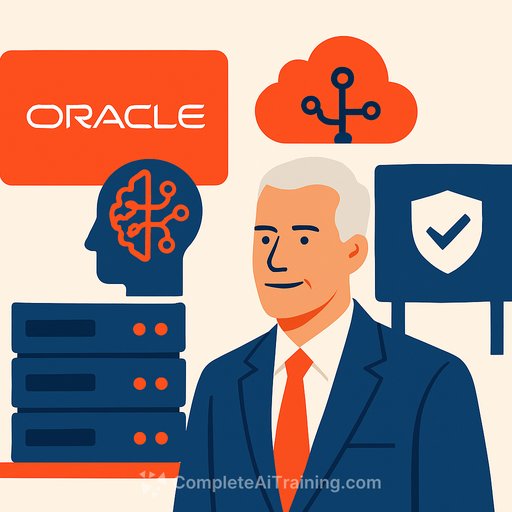Governance, Growth & AI: What Oracle's Leadership Change Means for Boards
Oracle has promoted Clay Magouyrk (ex-OCI) and Mike Sicilia (ex-Industries) to co-CEOs. Safra Catz moves to Executive Vice Chair, while Larry Ellison remains Chairman and CTO.
This is a precision move, not a scramble. It aligns the top job with where growth is concentrated: AI infrastructure, AI training and inference, and industry applications delivered at cloud scale.
From Succession to Strategy
The structure is built for focus and speed. Magouyrk's remit reflects platform and infrastructure; Sicilia's remit reflects industry solutions and AI-infused apps. Catz and Ellison anchor continuity and oversight.
The intent is clear: connect hardware to outcomes-GPUs to industry workflows-while keeping institutional knowledge intact at the board level.
The Profiles: Infrastructure & Applications United
Clay Magouyrk
Oracle Cloud Infrastructure's chief architect since 2014, with prior experience at AWS. He scaled OCI into a platform built for AI training, inference, and high-throughput workloads, while expanding regions and partnerships. Reported options: $250 million.
For context on the platform he helped shape, see Oracle Cloud Infrastructure.
Mike Sicilia
Led Oracle Industries across banking, healthcare, retail, and more. He integrated AI agents into vertical applications and accelerated modernization of legacy estates. Reported options: $100 million.
Together, the pairing links platform depth with domain outcomes-reducing the gap between compute supply and business value.
Why This Matters
- Cloud + AI where the revenue is. OCI's access to GPUs and AI demand puts infrastructure at the growth center. Elevating the leaders of infra and vertical apps concentrates strategy at the cash register of AI training, inference, and industry workloads. See the NVIDIA data center platform for a sense of the supply dynamic.
- Continuity without stasis. Catz retains board-level influence, Ellison stays technical and strategic, while Magouyrk and Sicilia run execution. The governance setup balances memory with mandate.
- Co-CEO risk managed by design. Clear domain lines-infra vs. industry apps-reduce overlap. Oversight at the board and founder level lowers the odds of turf wars.
- Market signal. The org chart matches the thesis: AI-first infrastructure plus industry-grade applications. Customers, partners, and investors get a coherent message.
Risks & Challenges to Watch
- Coordination strain. Ambiguous domains or shared KPIs create friction. Charters and decision rights must be explicit.
- Accountability dilution. Dual structures can slow decisions if consensus becomes a habit.
- Continuity vs. change. Board anchors should guide, not gate. New leadership needs room to move.
- Execution overload. Scaling infra while shipping vertical AI is complex. Sequencing matters as much as ambition.
What Boards, CEOs & Investors Should Learn
- Structure follows strategy. Don't re-org for optics. Design leadership around where value is created and defended.
- Pair complementary strengths. Domain-diverse co-leads can work if the seams are clean and incentives align.
- Stagger change with anchors. Keep institutional stability during handoffs, but limit drag on new execution.
- Signal intent with resources. Titles mean little without capital, talent, and roadmaps to match.
- Make AI a board-level agenda item. Treat infrastructure strategy and vertical AI adoption as core to business design, not side experiments.
30-90 Day Agenda for Boards
- Define charters and RACI. Codify decision rights across infra, apps, go-to-market, and shared services.
- Set joint OKRs with a tie-breaker. Establish shared targets and a clear escalation path for conflicts.
- Lock the AI supply chain. Validate GPU capacity, datacenter buildout, and networking commitments; set CapEx guardrails.
- Industrialize the use cases. Prioritize 5-7 vertical AI workflows with quantified ROI and referenceable early adopters.
- Align incentives. Tie variable comp to cross-business outcomes (attach rates, NRR, gross margin mix, deployment velocity).
- Customer advisory councils. Stand up by-industry councils to pressure test product direction and de-risk adoption.
Execution Signals to Monitor
- Capacity and regions. GPU hours contracted vs. delivered; OCI region launches and interconnect performance.
- Attach and adoption. AI feature attach rates in industry clouds; time to first value for new deployments.
- Revenue quality. Net revenue retention, gross margin by infra vs. apps, and cohort profitability.
- Sales velocity. Cycle time for AI workload deals; percent of pipeline tied to AI-specific SKUs.
- Ecosystem leverage. Partner-led deals, ISV integrations, and marketplace transactions per quarter.
Why the Model Could Work
AI growth depends on two flywheels spinning together: supply of compute and demand for outcome-specific solutions. Magouyrk owns the former, Sicilia scales the latter, and the board keeps the system aligned.
If Oracle holds the seams-clear charters, shared KPIs, and disciplined sequencing-it can compound advantages across infrastructure and vertical apps.
Bottom Line
This shift is bigger than succession. It is a leadership design built around AI-era growth, with governance to keep it stable and fast. For boards and CEOs, the takeaway is simple: set the org to match your thesis, then fund it to win.
If your executive team needs a focused upskill on AI infrastructure and vertical use cases, see Complete AI Training: Courses by Job.
Your membership also unlocks:






